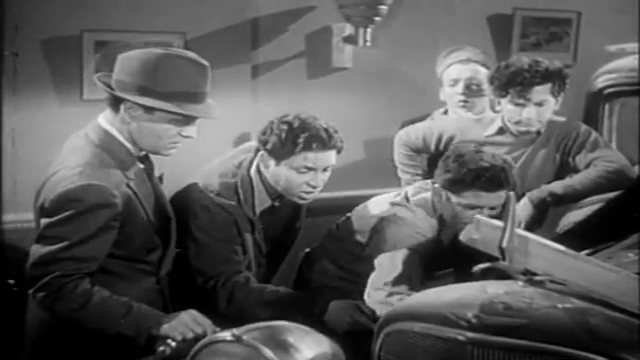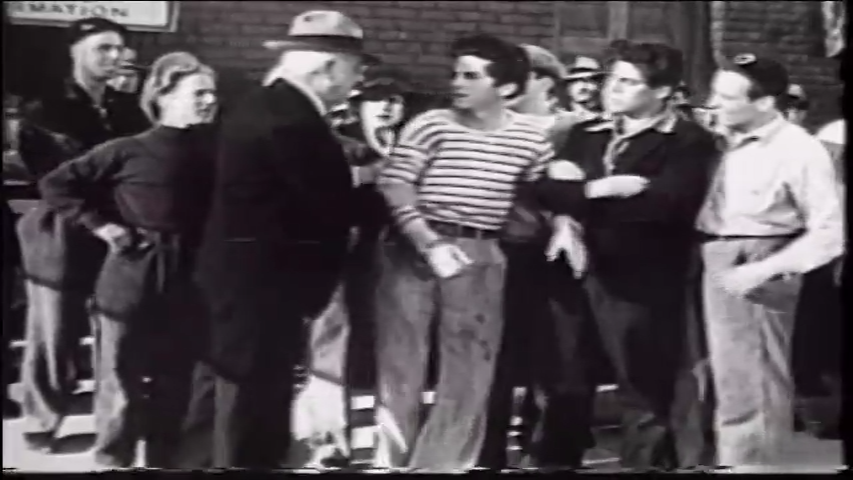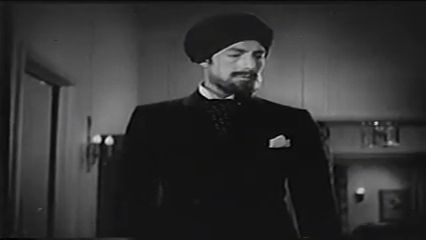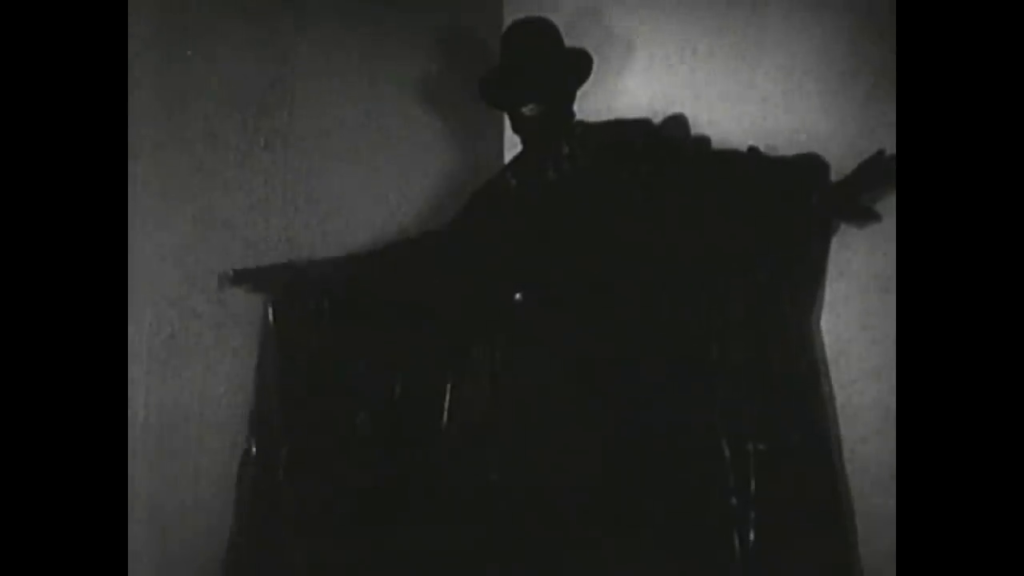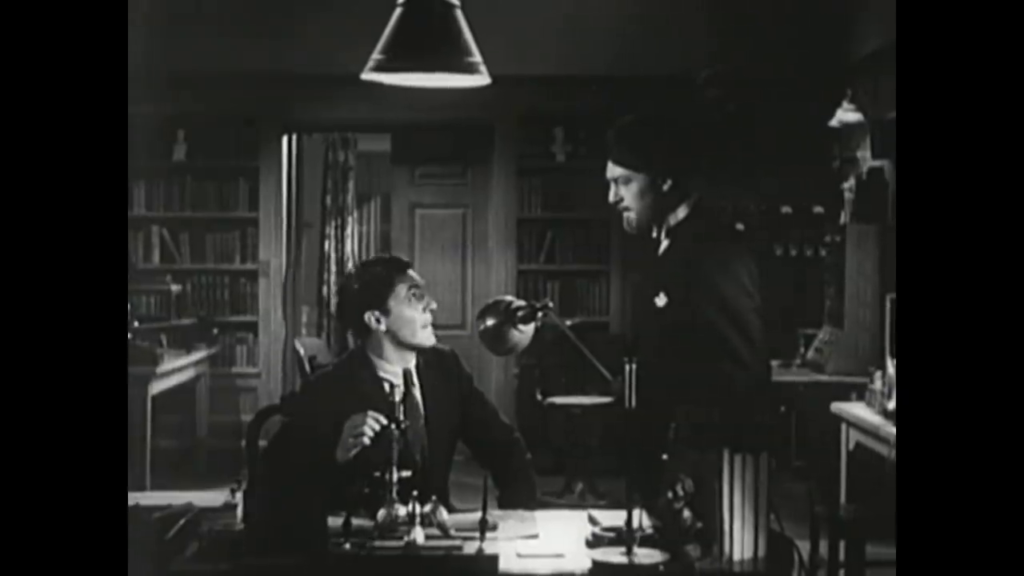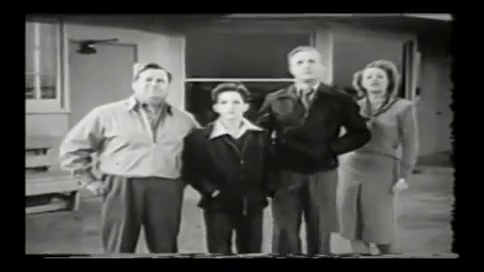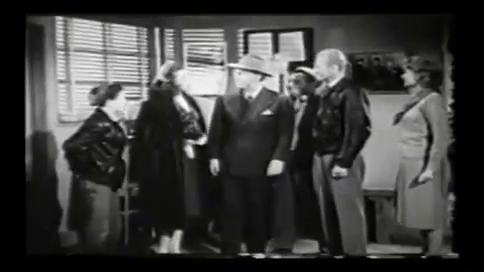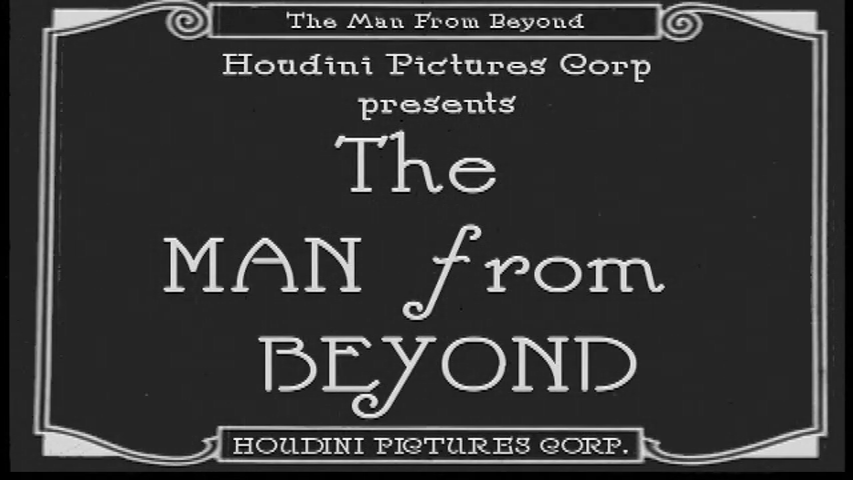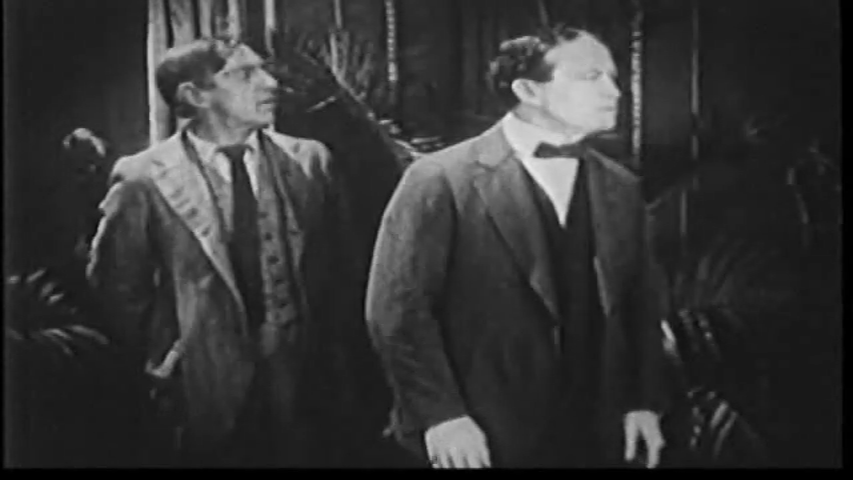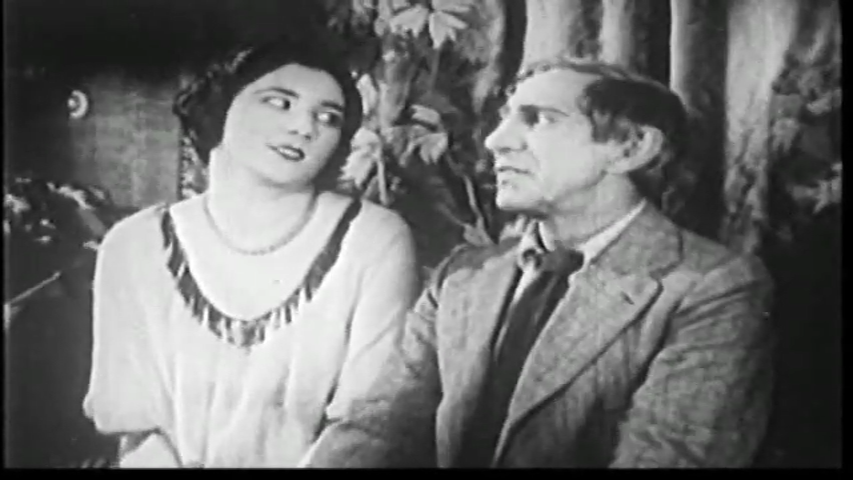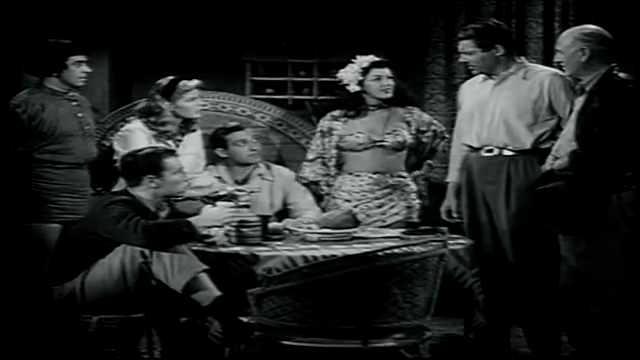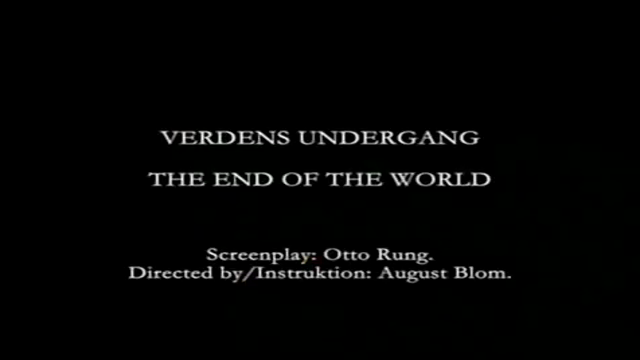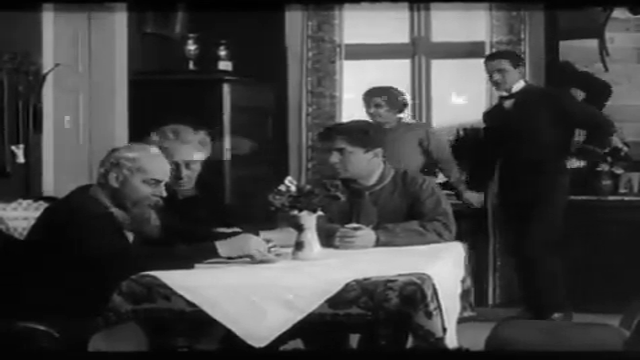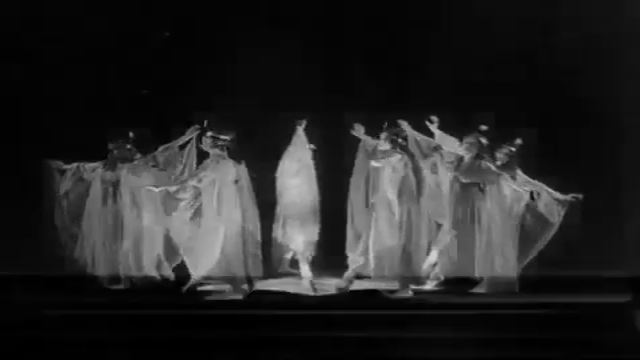-
#416 – Junior G-Men of the Air (1942)
Junior G-Men of the Air (1942)
Film review #416
Directors: Lewis D. Collins, Ray Taylor
SYNOPSIS: “Ace” Holden and his friends hang out at his Father’s airstrip, hoping to enter the local air race while Ace’s younger brother Eddie is inventing a new plane engine. Ace and his friends witness a bank robbery, and when they refuse to cooperate with the local G-man, they try and find the robbers, not realising that they belong to the “Order of the Black Dragonfly” a foreign organisation that is attempting to sabotage American industry and pave the way for an invasion. Ace and his friends join up with the junior G-men in order to combat this threat to themselves and their country…
THOUGHTS/ANALYSIS: Junior G-men of the Air is a 1942 film serial composed of twelve chapters, and the third to feature the young group of actors The Dead End Kids and The Little Tough Guys, although none of the serials are connected or have the same characters. This time, the kids are help to salvage junk at the airfield owned by the Father of one of the boys, Ace. While out collecting junk in their truck, they witness a robbery on a bank by a gang who steal their truck to make their getaway. Ace manages to get a strange broach of one of the men, but when the local G-man, Don Ames asks for the kids cooperation, they refuse due to their distrust of law enforcement. It turns out the robbers belong to a group known as the “Order of the Black Dragonfly,” a fifth column gang of saboteurs looking to destabilise American society to pave the way for a foreign invasion. As the serial progresses and Ace’s younger brother Eddie is kidnapped, the kids join up with the junior G-men, led by Jerry Markham, to find the gang and put a stop to them. The film’s plot is quite similar to Junior G-men, the first serial featuring the group of young actors, but while that one had a setting on land, and Sea Raiders focused on the sea, this one is centred around the air and aeroplanes, although there’s not too much action in the air. At least each of them have something unique about them. Other than that there’s not too much special about the story, but as with its predecessors, having the leads be these young, unruly boys rather than the typical all-american hero offers something a little different to the vast majority of serials.
The characters of the young actors are quite similar to the ones they played in the previous serials, but I suppose they are hired to play those specific roles. The leader of the gang, Ace, is the usual agitator and instigator, although he appears a bit more tidy than the previous serials for reasons I’ll get into below. At least his name isn’t Billy this time as well. Huntz Hall as “Bolts” plays his usual idiots sidekick routine without any real surprises, and “Stick” and “Greaseball” play mostly supporting roles, but they do have more lines and action than in the previous serials. While the kids are still troublemakers and somewhat hostile to any person of the law, they are less abrasive and unlikable than they were in previous serials, which again I’ll get into below. Other characters including “Double Face” Gordon add some variety to the line-up, while Don Ames as the G-man provide the more typical straight-laced law enforcement hero. Once again there’s no real female characters aside from a minor secretarial role, as it’s clear the serial is aimed at young boys of a more rebellious nature. The villains are classed as saboteurs, destroying America from within, and are obviously meant to be representing Japan. As is usual for these serials, The Japanese characters are all played by white Americans in make-up to “look” Japanese, which is not a good look to say the least, and a practice which sadly persevered for years in the film industry. Other than that, there’s nothing too remarkable about them.
Let’s get into the main aim of this serial: it is a giant propaganda piece for young Americans to serve their country in any way possible. By the time of the serials release, the U.S. had officially entered the Second World war after the attack on Pearl Harbour, and Anti-Japanese sentiment as overwhelming. A lot of these serial have secret Japanese societies of saboteurs fuelling this sentiment, as well as convincing the public to suspicious of everything around them. That the rough antics of the lead kids and their hostility to law enforcement is toned down in this serial compared to the previous ones is probably due to delivering this message that everyone must help their country in any way they can, in fact there’s multiple scenes that explicitly deliver this line. The final chapter of the serial is one big battle where the army storms the farm where the villains have set up a base, making it look like a battlefield and displaying the glorious victory of American troops. At the end everyone remarks about how vigilant they must be against enemies from within who threaten to destroy the American way of life, when they get new that Pearl Harbour has been attacked and they must now get ready for war and remain more vigilant than before. A lot of wartime serials push this messaging, but this serial is definitely more blatant about it than others I’ve seen. Maybe because it’s aimed at the younger rebellious generation that might be more reluctant to get behind their country. nevertheless, this makes for a much more interesting finale than you get in most serials, with the large scale battle making for an interesting payoff, even if it feels like mostly stock-footage not involving most of the main cast.
Overall, Junior G-men of the Air is a decent enough serial with plenty of action to keep younger viewers entertained. The overwhelming sense of wartime propaganda that fills some of the scenes is a bit much (although there’s definitely worse), and the frankly racist depiction of Japanese people as sneaky and devious is badly outdated, which was sadly not uncommon in film for a significant period of time. It doesn’t offer much that the previous two serials featuring the young actors doesn’t, but like the other two, at least does something a little different to most serials.
-
#415 – Sea Raiders (1941)
Sea Raiders (1941)
Film review #415
Directors: Ford Beebe, John Rawlins
SYNOPSIS: A gang of kids living by the harbour get wrapped up in a nefarious plot by a foreign agent to steal a new “torpedo boat” that is to be sold to the American government. The boat has been invented by Adam, who is Billy’s older, who is also the leader of the gang. When the plans for the boat are stolen, a local G-man named Brack Warren believes the kids are to blame, and tries to hunt them down. Billy decides that the only way to clear their name is to try and find who stole the plans and get them back before they are captured and Brack sends the kids to the desert…
THOUGHTS/ANALYSIS: Sea Raiders is a 1941 movie serial and the second universal serial featuring the group(s) of young actors known as the “Dead End Kids” and the “Little Tough Guys.” Junior G-men, the first serial was released the previous year. The story centres – as the title suggests – around the sea, where an unknown assailant termed the “Sea Raider” has been destroying ships carrying wartime supplies to America’s allies in Europe. Billy and his gang of street kids are causing trouble and trying to avoid getting caught by local officer Brack Warren, who wants to ship them off to the desert. Billy’s brother Tom has been developing a new torpedo boat that be sold to the government and shipped to its allies, but little does he know his friend Captain Carlton is secretly working with a foreign agent to steal the boat for his own country. When Tom’s workshop is broken into and his blueprints are stolen, Warren suspects Billy’s gang is behind the theft, and they decide to prove their innocence by tracking down the real thieves. The story is fairly similar to the usual serial format, but like its predecessor, deviates somewhat by having the lead characters not be a square-jawed, cowboy-esque white male, but instead this gang of rogue, slang-talking kids who constantly cause trouble. and rebel against authority. The plot flows nicely, and although it falls into some typical tropes of the format, it switches up the locations and perils enough to keep things interesting.
The kid characters, as mentioned, do eschew the typical lead roles, but their characters are almost identical to the ones they played in Junior G-Men. The young actors only play this very specific role though, but it is confusing that this isn’t a direct sequel, and even more so that the lead kid Billy is again playing a character named Billy (whose real name is also Billy). A lot of what I said about the characters from my review of the previous film featuring them still stands: the characters initially come across as rather unlikable, in that they are constantly causing trouble and stealing from people. It’s a bit more toned down in this film though, and their relatives dismiss their antics as mostly harmless. A lot of their antics are also directed at Brack Warren, a local police officer, who provides more of a comic relief role in his inability to apprehend the kids and his general incompetence, so the kid’s actions don’t seem so bad. Other than the main cast, the supporting cast are more in line with a typical serial, with a villain that is pretending to be the heroes friends, backed by a foreign agent (although the name of his country is not mentioned, he is obviously German). The theme of the serial around bewaring foreign spies and standing up for your country are typical of wartime serials, and like its predecessor, this one is perhaps aimed at younger viewers who like the kids in the serial are troublemakers, but can still support their country.
There aren’t too may serials with a focus on the sea, so that makes the serial stand out a bit more (The only other one I have seen is S.O.S. Coast Guard). This setting brings with it a lot of chases on the sea and even fights with sharks and an octopus. The camerawork is fairly decent, and the shots at sea are well done and convincing for the time. On the negative side, I noticed that the twelve chapters are a little shorter than usual. Given that the beginning of the chapter is a text-scrolling recap of the previous chapter, then there is playing the end of the previous chapter for the cliffhanger and it’s resolution, you are basically getting less than fifteen minutes per chapter, which if you’re going to the theatre every week seems like a bit of effort for little in return. On the other hand though, this means that the chapters are quick and fast-paced, so you’re not bored with scenes of pointless dialogue of characters explaining the plan they’re about to execute. Like it’s predecessor, Sea Raiders offers something a little different in the format: not too much, but enough. The story is familiar, but well-paced, and the action sequences are well done. The lead kids are a little erratic and difficult to root for when they act in their spiteful and rough manner, but they settle into the role of heroes well enough when confronting the real villains. Similar to Junior G-men, it’s worth a watch if you’re a fan of the format (although it doesn’t really work as a format nowadays), and would have been entertaining back when it was released too, I imagine.
-
#414 – Junior G-men (1940)
Junior G-Men (1940)
Film review #414
Directors: Ford Beebe, John Rawlins
SYNOPSIS: A group of street-wise kids led by Billy Barton are caught up in the deadly scheme of the “Order of the Flaming Torch” to sabotage and disrupt the government with the help of foreign agents to replace the government with their own men. F.B.I. agent Jim Bradford wants Billy’s assistance in locating his Father Colonel Robert Barton, who Billy hasn’t seen for five years, and who Brad ford believes is being held hostage by the Order. Billy and his gang are reluctant to help out any authority figures, and Bradford suggests they join up with his nephew Harry Trent, who is leading a group of junior G-men in town to aid the investigation…
THOUGHTS/ANALYSIS: Junior G-Men is a 1940 movie serial and the first of three starring the group of young actors referred to as the “Dead End Kids” and the “Little Tough Guys,” who starred in a number of films together. The serial starts off showing the gang of kids going round town being general nuisances. In the first few minutes, we see them steal, cause a car chase, start a fight, and generally just create chaos in their neighbourhood. From the start, these kids are not very likeable with their flagrant disregard for anyone else’s wellbeing but their own, and their constant hostility to any kind of law enforcement. An F.B.I. G-man named Jim Bradford questions Billy Barton, the leader of the boys, about the disappearance of his Father, and asks for Billy’s co-operation to find him. Again, the kids are aggressive and hostile about helping any “copper,” and leave. Jim Bradford suggests his nephew Harry Trent, a junior G-man, attempts to train the boys to take on the Order with them instead. Billy and the boys are initially hostile to this as well, but gradually start to work together with them to take down the “Order of the Flaming Torch” who have kidnapped Billy’s Father. The serial clears the antagonism between the characters eventually and it settles down into the usual hi-jinks of chases and fistfights that are expected of the format. The street kids also get to learn about the different techniques that the g-men use to investigate crimes, which leads to a blend of the street-wise and the methodical that works well.
The cast of characters are somewhat different to what you usually get in these serials. Billy Barton and the street-wise kids are certainly a contrast to the square-jawed, cowboy-esque men that are typically the stars of these serials as portraying a typical all-American heroism. Instead, Billy and his gang are rough-looking, unkempt and hostile to the law. The theme of the serial is, like many of the serials of the time, centred around the theme of spies, sabotage, and “bewaring the enemy within.” Billy and the gang are persuaded to put aside their contempt of the law for the sake of patriotism and their country. I think perhaps this serial was aimed at the rebellious younger generation in order to convince them to do the same thing in war-time as when this serial was released in 1941. Other than Billy, most of the other kids don’t get much screentime or dialogue apart from Lug, who provides the comic relief. Jim Bradford provides the more typical hero role that you usually see in these serials. Harry Trent as the junior G-man who is around the same age as the kids provides a good counter-act to Billy, and watching the two learn to work together gives the serial a good flow and sense of development as the serial unfolds. The villains are nothing special, but their interactions with their hostage Robert Barton (Billy’s Father), who is constantly trying to outwit them and escape, provides a source of ongoing tension. Outside of these characters, there’s nothing else worth mentioning; there isn’t even a single female character in the roster, other than Bradford’s secretary, who has maybe two or three lines.
Overall, Junior G-men is something a little different in the format, which is a rare thing. The main characters are not the typical heroes; they are rude, aggressive and at the beginning very unlikable. As the serial goes on, it settles into a more traditional flow as the kids ally themselves with the G-men. There’s enough going on at all times to maintain interest for the viewer, and a mix of different situations across the fairly large cast means the story moves along across all these characters equally well. On the negative side, as mentioned the kids are in the beginning rather unlikeable, but they do settle into the role later on. Also the action is a little crowded and uncoordinated, as sometimes the whole gang of kids get involves in a fight which makes it difficult to keep track of. The action scenes and cliff-hangers are nothing spectacular, but overall it’s nice to see something a little different from this format.
-
#413 – Sammy’s Super T-Shirt (1978)
Sammy’s Super T-Shirt (1978)
Film review #413
Director: Jeffrey Summers
SYNOPSIS: Young Sammy Smith is training hard to enter a local race. After he enters, a pair of bullies throw his lucky shirt up into the window of a factory. Sammy and his friend Marv sneak in to get it back, unsuspecting that the factory is a top secret laboratory, where Sammy’s shirt has been subjected to an experiment that has made it indestructible, and gives Sammy extraordinary strength when he wears it. The owner of the laboratory and his scientist find that Sammy has the shirt, and give chase before he can reveal the shirt’s secret…
THOUGHTS/ANALYSIS: Sammy’s Super T-Shirt is a 1978 British children’s film. At the start, we see twelve year old Sammy Smith exercising in his room trying to get stronger so he can compete in the local race. He goes to sign up for the race with his friend (and self-proclaimed manager) Marv, where the two are accosted by two bullies, who steal Sammy’s lucky T-shirt and throw it through an open window. It just so happens that the building the shirt lands in is a top secret laboratory where experiments on making an indestructible material are being carried out, and it also happens that Sammy’s shirt is used for the experiment that is successful. The lab’s owner, Mr. Becket and the scientist, Mr. Trotter, want to keep it a secret and exploit their discovery, but after Sammy and Marv sneak in to get the T-shirt back, they must find a way to get it back before the young boy ruins their discovery. The plot of the film is a very simple one, which mainly involves Sammy and Marv being chased by the two adults, and the various tricks they use. Not too much to say about it, but it’s easy enough to follow, and provides a few humourous moments through it’s slapstick comedy. Being only just under an hour long, everything is neatly wrapped up and there’s no real lull in activity, so it will keep it’s younger target audience entertained.
There’s something very nostalgic about this film: all of the locations are straight from their time. There’s no fancy sets or designs, just real locations that are a snapshot of the time. I imagine this would have been great for a young kid of the time, as these locations would have been just like the working-class streets they were growing up and played in, meaning their imaginations could run wild with the idea of running through their neighbourhoods with super powers. The child actors are also fairly good, and it would be easy to identify with young Sammy. His friend Marv being black and having a prominent role is something less than ordinary, as you certainly didn’t see many young black actors in these types of films, much less as just as much of an ordinary kid as the white lead. They do remark once how unusual their being seen together is (”one black and one white”), but other than that it just feels like two kids being kids without stereotypes, which is pretty cool.
While kids of the time of it’s release would have probably enjoyed the down-to-earth nature of the film, it is definitely dated today, and kids that may watch it now certainly wouldn’t get the same mileage out of it’s setting. Setups such as Sammy taking the clothing to the launderette to be washed just wouldn’t resonate, alongside the housing and manners of speech just wouldn’t reflect what we would recognise as “ordinary” today. Nevertheless, Sammy’s Super T-Shirt is a bit of short, harmless fun without too much merit. It feels like a time capsule of decades gone by, and if you grew up around this time, you would certainly get a wave of nostalgia through the locations and language used by the ordinary, working-class cast of the late seventies. Kids today won’t get anything out of it, but an interesting snapshot of times gone by.
-
#412 – The Spider Returns (1941)
The Spider Returns (1941)
Film review #412
Director: James W. Horne
SYNOPSIS: A masked criminal, known only as The Gargoyle, and backed by malicious foreign powers, aims to sabotage national defence production by targeting the owners of key industries. Criminologist Richard Wentworth must once again don the secret disguise of “The Spider,” a masked vigilante, in order to move outside of the rules and regulations of law enforcement, and along with his friends stop The Gargoyle before he can do irreparable damage to the country…
THOUGHTS/ANALYSIS: The Spider Returns is a 1941 movie serial and the sequel to the 1938 serial The Spider’s Web, based on the magazine comics of “The Spider.” The serial follows a similar setup to the first one, with criminologist Richard Wentworth secretly disguises himself as the masked vigilante The Spider in order to stop another masked individual known only as The Gargoyle, whose criminal gang is working to sabotage industries related to national defence. Sabotage really is the key word for the plot of this serial: it was released in 1941 in the context of the second world war and a heavy focus on the U.S. gearing up for getting fully involved. The concept of sabotage runs through a lot of wartime serials, with suspicion being placed on “the enemy within,” who would attack not from outside, but from the inside through the acts of sabotage. There’s a fair amount of wartime messaging throughout the serial, explaining how “our great country” is under threat from “foreign powers,” who will target key industries. No specific country names are mentioned, but you can figure it out. With this theme, the serial has a bit more of a darker tone to the story, but never anything overly scary, as these serials are generally aimed at younger audiences and bringing in families. To seemingly offset the darker tone, there’s some more silly moments, usually between The Gargoyle and his inventor assistant, as The Gargoyle berates him for his inventions going wrong. They do however make The Gargoyle feel a bit less threatening, but again that may have been the purpose to make the serial a bit more family-friendly, and the villain less scary, while still getting the wartime message through. Overall though, it does present a bit of a mismatch that makes the comedy seem on the whole out of place.
All of the protagonists from the first serial make a return here, although only two of the original actors reprise their roles: Warren Hull as Richard Wentworth AKA The Spider, and Kenne Duncan as Wentworth’s chauffeur Ram Singh. Dave O’Brien, who was Hull’s stunt double in the first serial, now takes over as Jackson, Wentworth’s assistant. The characters more or less have the same roles as they did before, but perhaps have less to do than they did in the first serial, which balanced out the use of the characters a lot more than most serials. Hull performs the triple role of Wentworth, The Spider, and Wentworth’s disguise Blinky McQuaid, a petty criminal who Wentworth disguises himself as in order to go undercover and get information from The Gargoyle’s henchman, and his multi-faceted role is very much the centrepiece of the story. The different roles give enough variety to the situations, and causes Wentworth to consider his actions in terms of how each character is perceived, such as police commissioner Kirk’s attempts to catch The Spider, and who always has suspicions that Wentworth is the masked vigilante. As mentioned, the villains are a bit less threatening in their hapless endeavours, as The Gargoyle gets into some comedic banter with his inventor assistant, and using his X-Ray eye machine, spies on his underlings to see they are having a party instead of doing his evil work.
While The Spider’s Web was a wildly popular serial that probably (in part) sparked the trend of masked superhero serials, The Spider Returns isn’t quite as good as its predecessor, but is still a decent example of the format, with enough variety through Hull’s triple performance, the sci-fi inventions used by the villain, and the focus on sabotage and its wartime message has some impact. The trend of masked superheroes faded away after the war was over, instead making the leads more military-like and ordinary to reflect the victorious soldiers of the war. However I think the escapades of The Spider shouldn’t be forgotten, as they were very influential in the production of the serial format in its time.
-
#411 – The Spider’s Web (1938)
The Spider’s Web (1938)
Film review #411
Directors: James W. Horne, Ray Taylor
SYNOPSIS: A wave of crime across the city targeting key infrastructure and transportation networks is being conducted by a criminal mastermind known only as “The Octopus” with aims to take over all the key utilities and companies. Criminologist Richard Wentworth must don his secret identity of “The Spider” in order to thwart The Octopus’ plans outside of the police’s rules and regulations…
THOUGHTS/ANALYSIS: The Spider’s Web is a 1938 serial based on the comic book character “The Spider” (not to be confused with spider-man). The serial starts out strongly as most of the format does in order to entice viewers back week after week. In the opening chapter contains plane crashes, car chases, fist fights and a heap of explosions, so there’s definitely plenty of bang for your buck. The explosions and destruction of key transport and city infrastructure is being carried out by a criminal mastermind known only as “The Octopus,” who seeks to put his own men in charge of all these utilities by killing off the current managers of them. Renowned criminologist Richard Wentworth is travelling home on his plane with his sweetheart Nita van Sloan when their plane is attacked and they have to parachute out. Wentworth learns of this new crime wave and decides to once again become the masked vigilante “The Spider,” who chases crime where the rules and regulations of the police cannot go, even though he promised Nita that he had retired from the costumed life. The story is a standard serial affair of the hero foiling the villain’s various schemes across the fifteen chapters, and while it does not do much unique in terms of story, it still executes the usual plot points in a fun and interesting way, and with a good level of competency.
The characters are a typical cast of serial characters. Wentworth is the usual lead character, Nita is the sole female character, and Jackson is the sidekick who gets in on some of the action. Ram Singh is Wentworth’s assistant who is clearly meant to be Indian, but is portrayed by a white American and refers to him as “Master” occasionally like he is a servant. and that is obviously a problematic stereotype of non-white people being subservient to them. Wentworth himself is very much like Batman’s alter-ego Bruce Wayne: he is rich, clever, works alongside the police, but when he dons his mask to fight crime, he is wanted by them. He can also disguise himself as a known criminal “Blinky” McQuaid, which he uses to get close to the criminals and get the information on their plans. These different facets to the main character add some good variety to the serial, and make the lead a bit more stand-out from the sheer volume of serial leads which all look and act the same. The Octopus as a villain is shown to be cunning and ruthless, as he executes those who fail him. His being dressed in a white hood and cloak mirrors the Spider’s outfit, which is almost the same, but in black. The identity of The Octopus is, unusually for such a serial, never really explored or even revealed in the finale, and we are only told he is one of the most powerful men in the city.
At the time of it’s release, The Spider’s Web was a huge success, and it is easy to see why: it doesn’t deviate from the serial format, but does all its tropes pretty well. The character of The Spider as a masked vigilante probably helped kick-start the popularity of masked superheroes, and serial adaptations in the 1940s. The Green Hornet, one such serial, is practically identical in both story and characters, with the masked vigilante stopping crime and eluding the police, while being aided by a foreign sidekick.
-
#410 – Hop Harrigan (1946)
Hop Harrigan (1946)
Film review #410
Director: Derwin Abrahams
SYNOPSIS: Hop Harrigan, a pilot along with his buddy “Tank” Tinker, are hired to escort a scientist to his secret laboratory hidden in the mountains, where he is working on a powerful new source of energy. Meanwhile, a man known only as the “Chief Pilot” is after the invention for himself to use as a deadly weapon. Hop and his friends are caught up in the schemes of all of these players, and they must stop them before disaster befalls the world…
THOUGHTS/ANALYSIS: Hop Harrigan is a 1947 movie serial based on the Hop Harrigan character from the All-American Comics series, as well as the radio plays. Harrigan became quite popular during the course of the second World War, probably due to his heroic piloting antics which would have resonated with the population. However, his population waned after the war ended along with many of the similar characters, with people rather turning their attention to costumed superheroes and the villains being spies rather than soldiers. The serial starts off with Hop performing a mid-air rescue, then returning back to the airfield where he works. he is offered a job by a man named Arnold to fly a scientist named Dr. Tobor to his secret laboratory. Tobor has been working on an invention that runs on a powerful new energy, and has to keep Hop and Tank blindfolded while in the air so they do not see where the lab is. Meanwhile, an unknown person calling himself “The Chief Pilot” is intent on getting a hold of Tobor’s invention for himself, and sends his goons to kidnap him. The plot of the serial as always follows the standard format of each chapter having a different scheme or plot to foil, with it ending on a cliffhanger for the next chapter. I imagine the serial format isn’t the best one to adapt Hop Harrigan in, as he is probably more used to dealing with soldiers and villains rather than engaging in thwarting espionage, but again that’s like a lot of the serials, which used the name of a comic book character and didn’t really adapt anything else about them.
On the heroes side, you have the standard All-American heroics of Hop Harrigan, his sidekick and comic relief “Tank”, who offers some decent interactions with his goofiness playing off against other characters. Gail is the token female character who runs the airfield (though she doesn’t really do much), and her younger brother Jackie, whose book-smarts often clash with Tank’s brute-force approach. Jackie provides a good example of a younger characters which the kids in the audience can relate too, and he has a decent amount to do, which helps in that regard. Other than that though, the heroes are pretty unremarkable. There are quite a few villains in this serial, ranging from the mysterious Chief Pilot, whose identity isn’t revealed until the end (a typical serial trope), and an array of henchman, some of whom are working with the Chief Pilot, and some who are working for Hop’s employer Arnold and secretly working against him. There’s also Dr. Tobor (’Robot’ spelled backwards in case you hadn’t noticed; I’m pretty sure I’ve watched another serial or film which uses the same name, but I can’t remember which), who essentially plays the eccentric scientist who becomes more and more erratic as the serial progresses. He is sought by both heroes and villains, and constantly tricks them and plays them for fools, which shakes up the dynamic. Tobor as the wildcard element helps to give a bit of an original edge to the story, and that is welcome.
If you’re going to watch a Hop Harrigan serial, then no doubt you’ll be expecting plenty of scenes in the sky and plane fights. The serial more or less delivers what it promises with plenty of scenes taking place in the air, and shot reasonably well for the time, but most of the action does take place on the ground, and the plane scenes are just to travel from place to place, or to follow a car from the air.
-
#409 – The Man from Beyond (1922)
The Man from Beyond (1922)
Film review #409
Director: Burton L. King
SYNOPSIS: An expedition finds a shipwreck frozen in the Arctic. On board, they find a man encased in ice. They begin to free him, and learn from the journals on the ship that the man was frozen over one hundred years ago in 1820. They decide to not tell him about this until they are ready to announce his discovery to the world. When the man is taken to the home of a scientist, he sees a woman being married that he believes is the same one he loved over one hundred years ago. Little does he know, he is interrupting an evil scheme undertaken by the man she is marrying…
THOUGHTS/ANALYSIS: The Man from Beyond is a 1922 film starring the famous escapologist Harry Houdini. At the start of the film, we see two men on an expedition in some frozen wastelands, when they stumble across a ship embedded in the ice. Dr. Sinclair, the head of the expedition, learns that the ship had been wrecked in 1820, over one hundred years ago through reading some of the journals on board. They find a man encased in ice who they are able to thaw out. The man wakes up and still believes he is in the year 1820, and Dr. Sinclair decides not to tell him how long he has been frozen until he is returned to civilisation where his discovery can be announced to the world. He is brought to the home of Dr. Sinclair by car…which is a bit odd considering that there were no cars in 1820, and so the man should probably have been suspicious about what was going on? Anyway, the man, Howard Hilary, sees that a wedding is going on between a man named Dr. Trent and a woman named Felice…who resembles the woman he loved before he was shipwrecked, also called Felice. Hilary interrupts the wedding believing the Felice he knew has abandoned him, but this Felice has no idea who he is.
The man Felice is to marry, Dr. Trent, is planning to marry her so he can get his hands on her Father’s property. Her Father, Dr. Strange (no, not the Marvel superhero) has been missing for nearly a year after he went along for the voyage, but apparently got a not saying his daughter was sick, and never returned home. The plot mainly revolves around Hilary attempting to stop Dr. Trent from marrying Felice and uncovering his evil scheme, while attempting to find her Father. I feel like the film could have done more with the premise of a man waking up after one hundred years. Instead, it focuses on a love story and an evil scheme that doesn’t really live up to what it could have been. The story is well put together, and the pacing is decent enough along with a varied cast of characters, but not enough attention is given to the novel premise of the film. Being a Houdini film, there are a few scenes of him performing some escape acts, and the finale being set on a raging river delivers some entertaining action that adds variety.
The film opens up showing a quote from the bible, which I assume is due to the whole theme of bringing someone back from the dead and reincarnation would have been controversial and heretic for a film at the same, so the film frames the events in this Christian way to avoid these accusations (which would be my guess anyway). Another interesting reason for this may be because the film was also a means for Houdini to restore his friendship with Sir Arthur Conan Doyle, the writer of the Sherlock Holmes stories. Doyle, while not particularly religious, was an enthusiast for Spiritualism, and wrote two books on the legitimacy of seances, communicating with the dead, ectoplasm and such forth. Houdini was a vocal sceptic of spiritualism, and the pair fell out during a seance where Houdini’s Mother was supposedly speaking from beyond the grave through a medium, and Houdini was enraged when the medium spoke in English, even though Houdini’s Mother only ever spoke and understood German. It seems to have had the desired effect, as Doyle praised the film and its message. Whether Houdini really changed his mind or not on spiritualism I’m not sure, but it’s an interesting story.
Overall, The Man from Beyond is a decent story for the time, with some good special effects and the expected Houdini escape feats. It’s messaging around reincarnation is a bit muddled however, and the unique premise of a man who has been frozen for over a hundred years having to adjust to ‘contemporary life’ isn’t really given any thought or focus. If you want a film which does that, the 1930 film Just Imagine! is probably one of the earliest examples.
-
#408 – Jack Armstrong (1947)
Jack Armstrong (1947)
Film review #408
Director: Wallace Fox
SYNOPSIS: When a valuable shipment and scientist Vic Hardy are kidnapped, young Jack Armstrong along with his friend Billie, his Sister Betty, and their Uncle Jim Fairfield, all attempt to find and rescue him. They eventually track him to an island in the Pacific, where an evil scientist has hidden Hardy away in a secret laboratory where he is building a weapon that could enslave the world. Jack and his friends must deal with the native islanders and the scientist’s henchman before the weapon is completed and the world is at their mercy…
THOUGHTS/ANALYSIS: Jack Armstrong is a 1947 movie serial based on the radio play of the same name.The serial opens up with young Jack Armstrong and his friend Billie along with his sister Bettie working on a car at the Fairfield aviation company, which Billie and Bettie’s Uncle Jim owns. Almost as soon as the serial starts, a hit and run takes place outside the Fairfield office, so Jack and Billie jump in their car and give chase. This car of theirs is a huge beast that just looks like a big steel box put over a normal car. Nevertheless, it gives the opportunity for the serial to open on an action-based note, and to entice viewers to stay and come back for the rest of the serial’s chapters. After Jack and Billie catch the driver, their car is never seen or mentioned again, which is a bit naughty opening with it and thus giving the impression you will see more of it in the next chapters.
One of Jim’s employees, Hardy, is monitoring some strange signals in the ionosphere. One of Jim’s customers named Pearce overhears this, who is working for the gang making those signals for some evil scheme, and has Hardy kidnapped so he can be forced to help with their plan. Jack and the gang track Hardy down to an island in the Pacific Ocean, which they travel to, but their plane is shot down on approach. The rest of the serial takes place on the island, where they meet the owner of a trading outpost named Grood, who is secretly the mastermind of the evil scheme to rule the world through building a weapon and deploying it in the atmosphere. The story involves Jack and the gang dealing with Grood’s henchman, as well as the native tribes that inhabit the island, and later on Pearce when he shows up on the island still pretending to be our heroes friends.
-
#407 – The End of the World (1916)
The End of the World (1916)
Film review #407
Director: August Blom
SYNOPSIS: When it is discovered that a comet is due to pass by Earth, panic and uncertainty over whether the comet will actually strike the planet. Stoll, a stock broker, sees an opportunity to make some easy money preying on people’s fears, but when the danger becomes too real, he and his wife must return to the small mining town which she fled in order to marry Stoll…
THOUGHTS/ANALYSIS: The End of the World (Verdens Undergang, also sometimes titled The Flaming Sword) is a 1916 Danish science-fiction film. The film starts off with the inhabitants of a small mining town visited by the mine’s owner, Stoll. When Stoll meets Dina, the daughter of the mine foreman at a dance, he suggests that she run away with him back to the city. Following a chastising from her Father about being a “harlot” for staying out late on her own (such as it was in 1916 I guess), Dina decides to run away with Stoll, leaving behind her Sister, Father and her friend Flint, who had hopes of marrying her himself. Fast forward a few years and we see that Stoll is a successful financier whose stock market dealings have left him very rich, and his now wife Dina has everything she could ideally want. The beginning of the film really takes some time to establish the characters and their relations. Stoll is the focal point of much of the film, and while he is marked as the villain throughout much of what is going on, he is still portrayed as having some humanity in his faithfulness and dedication to his wife. Ultimately, his manipulation of the stock market and his treatment of the mine’s workers leave him as very much an enemy to many of the other characters. Being perhaps one of the first disaster movies ever, it does the job of portraying how the end of the world impacts a number of different people from different walks of life.
When Professor Wisemann sees a new comet through his telescope coming towards Earth, the discovery generates a lot of uncertainty and panic across the world, as no one seems to know if the comet will hit the Earth or not. Stoll learns from his brother that the comet will probably hit the Earth in northwest Europe and cause significant devastation, and devises a scheme to buy a large number of stocks while there is panic, and have his friend at a newspaper print the (false headline) that the comet will not hit, leading Stoll to sell his stocks at a higher price and become even more wealthy. Even when Stoll learns of the comet’s impact, he insists the newspaper print the misleading story that it will pass by Earth so he can fulfil his scheme. Again, Stoll is made out to be the villain because profiteering over the end of the world is hardly going to go down well is it? Meanwhile, events in the mining town are moving along as Dina’s sister says farewell to her sweetheart Reymers, who has just graduated as a sailor and is leaving on board a ship.
In the third act, with the comet looming ever closer to Earth, Stoll realises the only place he can take shelter is the mine in the town where he met Dina: however, the populace are less than happy at Stoll over the way he has treated their town, and when they learn he is coming to town, Flint organises an attack on Stoll. Dina is also reluctant to return to the town, but is finally convinced. As the comet gets closer, Stoll organises a party for the end of the world, while the workers decide they are going to storm the party, setting the conflict for the final part of the film. As the comet enters the atmosphere, fragments start to rain down over the town causing mass destruction. The special effects are quite remarkable for their time, even if they’re typically just sparks flying over model buildings. Also the image of a comet overlaid into the sky of some scenes gives a feeling of impending doom. The film enjoyed a fair amount of success when it was released; in part capitalising on the fear and uncertainty surrounding Halley’s comet passing Earth a few years before, and the ongoing war in Europe which alerted people to a level of destruction they had never considered before. The film’s showing of mass destruction from meteors, houses being shaken and destroyed, and huge tidal waves gives a fair variety to the devastation and gives the feeling that nowhere is safe in these situations.
The film ends with most of the characters dying: Stoll and his wife are killed in the mine they are hiding in, Flint chases them, but the release of deadly gas kills him too. Dina’s Father passes away, and at the end we see Edith, Dina’s sister alone as she has miraculously survived. She goes up to the top of the church and rings the bell in the hope of alerting other survivors. Coincidentally, it turns out Reymers has managed to return to shore from the ship he was on, and on hearing the bell, the two are reunited to end the film on a somewhat happy note, that even through all the destruction, a sliver of hope has survived. Overall, The End of the World is a well-written spectacle that offers effects and a speculative scenario that film-goers would probably have not seen before. It’s relevance to the time is clear in regards to the amount of destruction the world was experiencing through war. The film does a good job of establishing a variety of characters and connecting them to each other, as we see how the disaster will affect people of different class and occupation, which has become one of the foundations for disaster movies. The spectacle would have engrossed movie-goers of the time, but there’s enough substance in the characters to appreciate the story underneath the spectacle too.



